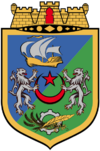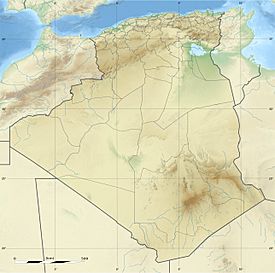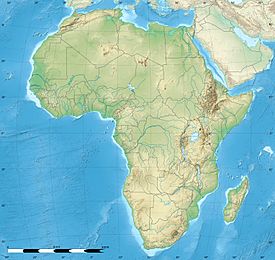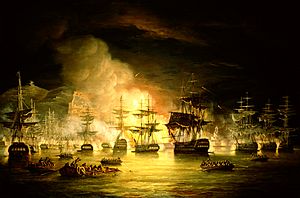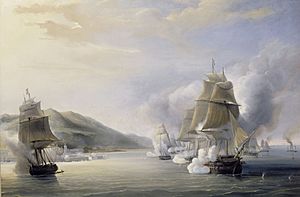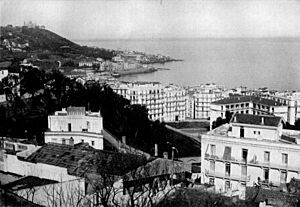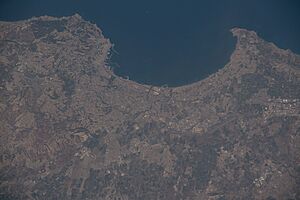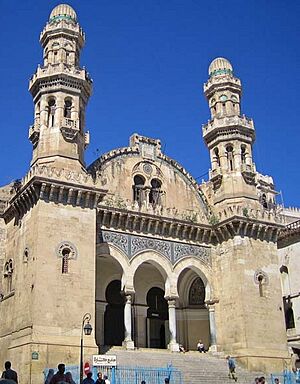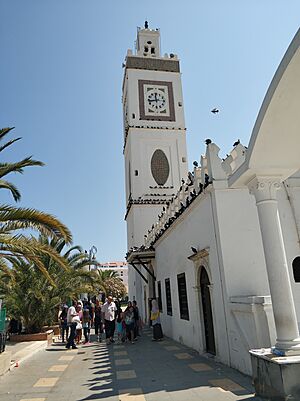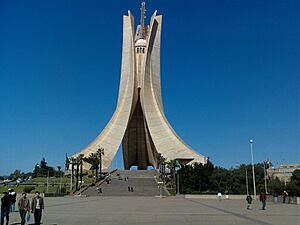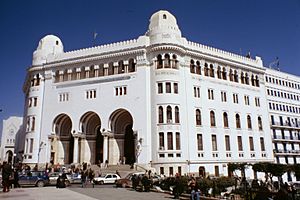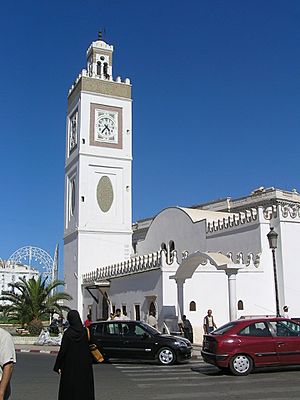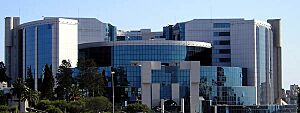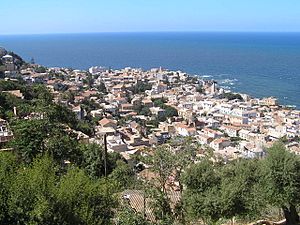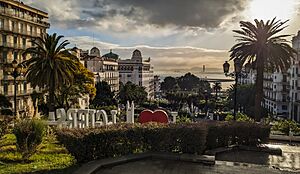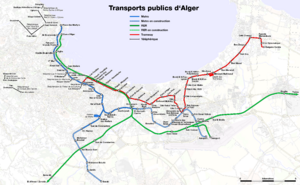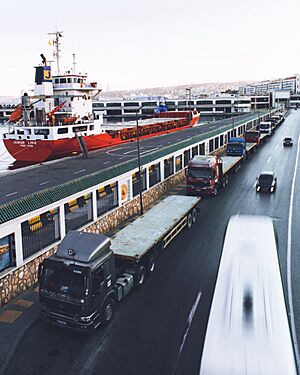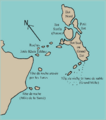Algiers facts for kids
Quick facts for kids
Algiers
الجزائر
al-Jazāʾir
|
|||
|---|---|---|---|
| الجزائر العاصمة | |||

Clockwise, top left: Coast of Algiers, Maqam Echahid (Martyrs' Memorial), Djamaa el Djazaïr, Ketchaoua Mosque, Kasbah of Algiers, Algiers Central Post Office, Ministry of Finance building
|
|||
|
|||
| Nicknames:
Algiers the White; Algiers the Dazzling
|
|||
| Country | |||
| Province | Algiers Province | ||
| District | Sidi M'Hamed District | ||
| Incorporated | 944 | ||
| Area | |||
| • Capital city | 363 km2 (140 sq mi) | ||
| • Metro | 1,190 km2 (460 sq mi) | ||
| Highest elevation | 424 m (1,391 ft) | ||
| Lowest elevation | 2 m (7 ft) | ||
| Population
(2011)
|
|||
| • Capital city | 4,510,000 | ||
| • Density | 12,424/km2 (32,180/sq mi) | ||
| • Metro density | 7,012/km2 (18,160/sq mi) | ||
| Time zone | UTC+01:00 (Central European Time) | ||
| • Summer (DST) | (Not Observed) | ||
| Postal codes |
16000–16132
|
||
| Area code(s) | (+213) 021 | ||
| Licence plate | 16 | ||
| Climate | Csa | ||
| Official name: Casbah of Algiers | |||
| Type: | Cultural | ||
| Criteria: | ii, v | ||
| Designated: | 1992 (16th session) | ||
| Reference #: | 565 | ||
| Region: | List of World Heritage Sites in North Africa | ||
Algiers (pronounced al-JEERZ) is the capital and largest city of Algeria. It's also the main center for government, business, and culture in the country. About 4.5 million people live here.
Algiers is located on the northern coast of Algeria, right on the Bay of Algiers. It's one of the biggest cities in North Africa, the Arab world, and the Mediterranean Sea. This makes it an important place for culture, arts, food, and trade.
The city has many important buildings and places. These include the Algiers Opera House, the National Museum of Fine Arts of Algiers, and the Bardo National Museum (Algiers). You can also find the huge Djamaa el Djazaïr mosque, which is the third largest in the world. The Botanical Garden Hamma is a beautiful green space.
Algiers has a modern public transport system. This includes the Algiers Metro (subway), the Algiers tramway, and even Gondola lift lines that help people get around the hilly areas. It also has a major international airport, Houari Boumediene Airport.
The city has hosted many big sports events. These include the 1975 Mediterranean Games and the 2007 All-Africa Games.
Contents
Names of Algiers
The name Algiers comes from the French and Catalan word Alger. This word comes from the Arabic name al-Jazāʾir (الجزائر), which means "The Islands". This name refers to four small islands that used to be off the city's coast. These islands became part of the mainland in 1525.
Long ago, the ancient Greeks called the town Ikósion. The Romans later called it Icosium. The Greeks had a story that the name came from their word for "twenty" (eíkosi). They said it was founded by 20 friends of Hercules when he visited the area.
Algiers is also known as el-Behdja (البهجة), meaning "The Joyous". Another nickname is "Algiers the White" (Alger la Blanche) because of its many white buildings.
History of Algiers
The city's history goes back to about 1200 BC. It started as a small port for the Phoenicians, who were traders. Later, around 202 BC, the area became part of Numidia.
Roman and Vandal Times
Around 42 AD, the Romans took control and called the town Icosium. It became an important Roman town. In 435 AD, the Vandal Kingdom took over northern Africa, including Icosium. The city was damaged in fights but kept growing.
Medieval Period
In 534 AD, the Byzantine Empire (Eastern Roman Empire) took control. Later, in the late 600s, the Muslim conquest of the Maghreb brought Islamic rule to North Africa. The city was re-founded in 972 AD by Buluggin ibn Ziri. He was a governor for the Fatimid Caliphate. The city was then called "Jazaʾir Banī Mazghanna".
Over the centuries, different empires ruled Algiers. These included the Zirid dynasty, the Hammadid dynasty, the Almoravid Empire, and the Almohad Caliphate.
Ottoman Rule and Pirates

In the early 1500s, the Spanish built a fort on an island near Algiers. In 1516, the local leader invited two famous corsair (pirate) brothers, Oruç Reis and Hayreddin Barbarossa, to help remove the Spanish. They succeeded, and Hayreddin made Algiers a strong base.
Algiers became the main base for the Barbary pirates. These pirates attacked ships in the Mediterranean Sea and captured people to hold for ransom. By the 1600s, many people in Algiers were enslaved Europeans. Famous writer Miguel de Cervantes was held captive here for almost five years.
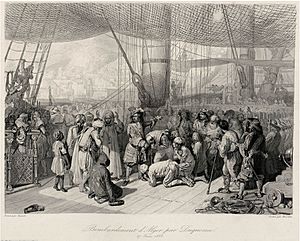
Many countries tried to stop the pirates. The United States even fought two wars against them. In 1816, a British and Dutch fleet attacked Algiers and destroyed the pirate ships.
In 1827, a disagreement between the ruler of Algiers, Hussein Dey, and the French consul led to a big problem. The French demanded an apology, but it didn't happen. This led to a naval blockade by the French.
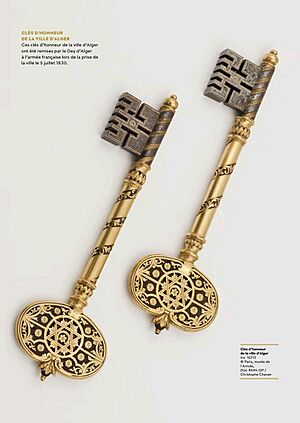
In 1830, France invaded Algiers. The French forces defeated the Algerian army, and Hussein Dey surrendered on July 5, 1830.
French Rule
Algiers became the capital of French Algeria. France wanted to make Algeria part of France and brought many European settlers to live there. Laws were made that gave French citizenship to Europeans but made it harder for local Algerians. This led to a separation between different groups in the city.
Many Europeans moved to Algiers. By the early 1900s, they made up most of the city's population. During World War II, Algiers was the first city in North Africa to be taken by the Allies from the Axis powers.
Algerian War for Independence
Algiers played a very important role in the Algerian War (1954–1962). This was a difficult struggle for independence where many lives were lost. The "Battle of Algiers" was a key part of this war. It involved intense fighting between Algerian independence fighters and the French army.
Independence and Modern Times
Algeria became independent on July 5, 1962, with Algiers as its capital. Since then, the city has grown a lot and now has about five million people.
In 1988, there were big protests in Algiers called the "Spring of Algiers". People wanted an end to the single-party system and more democracy. This led to a new constitution in 1989 that allowed more political parties and freedom of the press.
In the 1990s, Algeria faced a civil war. Algiers saw many political demonstrations during this time. In 2007, two car bombs exploded in Algiers, causing many injuries and deaths.
Geography of Algiers
Algiers is in the north-central part of Algeria. It stretches along the Bay of Algiers and onto the nearby plains and hills. The city is mostly at sea level, but some parts are higher up, reaching about 407 meters (1,335 feet). Two rivers, the Oued El Harrach and the Mazafran River, flow near the city.
Districts of Algiers
- The Casbah: This is the old part of Algiers, built on a hill. It has narrow, winding streets and old buildings from the 1600s. It's divided into a High City and a Low City. The Ketchaoua Mosque and Djamaa el Kebir are here.
- Bab El Oued: This is a popular district that starts near the Casbah. It's known for its "three clocks" square and markets.
- Edge of Sea: This area was built after 1840 with new buildings like the town hall and theater. It has an elegant walkway along the sea.
- Kouba: An old village that became part of Algiers as the city grew. It has many houses and smaller buildings.
- El Harrach: A suburb about 10 kilometers (6 miles) east of the city.
- Hydra, Ben Aknoun, El-Biar, and Bouzareah: These are called the "Heights of Algiers". Many foreign embassies, government offices, and universities are located here.
- Didouche Mourad street: This is a main street in the city center, known for its shops and restaurants. It's considered the heart of the capital.
Climate of Algiers
Algiers has a Mediterranean climate. This means it has hot, dry summers and mild, wet winters. The nearby Mediterranean Sea helps keep the temperatures from getting too extreme.
Algiers gets about 600 millimeters (24 inches) of rain each year, mostly from October to April. Snow is very rare. In 2012, the city had its first snowfall in eight years.
| Climate data for Algiers (Houari Boumediene Airport) 1991–2020, extremes 1838–present | |||||||||||||
|---|---|---|---|---|---|---|---|---|---|---|---|---|---|
| Month | Jan | Feb | Mar | Apr | May | Jun | Jul | Aug | Sep | Oct | Nov | Dec | Year |
| Record high °C (°F) | 27.6 (81.7) |
31.4 (88.5) |
36.3 (97.3) |
36.5 (97.7) |
41.1 (106.0) |
44.6 (112.3) |
48.7 (119.7) |
47.5 (117.5) |
44.4 (111.9) |
39.5 (103.1) |
34.4 (93.9) |
30.4 (86.7) |
48.7 (119.7) |
| Mean daily maximum °C (°F) | 17.1 (62.8) |
17.5 (63.5) |
19.7 (67.5) |
21.8 (71.2) |
25.0 (77.0) |
29.0 (84.2) |
32.1 (89.8) |
32.9 (91.2) |
29.8 (85.6) |
26.5 (79.7) |
21.2 (70.2) |
18.2 (64.8) |
24.2 (75.6) |
| Daily mean °C (°F) | 11.3 (52.3) |
11.5 (52.7) |
13.6 (56.5) |
15.6 (60.1) |
18.8 (65.8) |
22.6 (72.7) |
25.7 (78.3) |
26.6 (79.9) |
23.9 (75.0) |
20.4 (68.7) |
15.7 (60.3) |
12.6 (54.7) |
18.2 (64.8) |
| Mean daily minimum °C (°F) | 5.5 (41.9) |
5.6 (42.1) |
7.5 (45.5) |
9.4 (48.9) |
12.6 (54.7) |
16.2 (61.2) |
19.4 (66.9) |
20.4 (68.7) |
17.9 (64.2) |
14.3 (57.7) |
10.1 (50.2) |
7.0 (44.6) |
12.2 (54.0) |
| Record low °C (°F) | −3.3 (26.1) |
−1.9 (28.6) |
−1.0 (30.2) |
−0.8 (30.6) |
2.6 (36.7) |
5.5 (41.9) |
9.0 (48.2) |
9.5 (49.1) |
8.2 (46.8) |
4.1 (39.4) |
−0.1 (31.8) |
−2.3 (27.9) |
−3.3 (26.1) |
| Average precipitation mm (inches) | 84.2 (3.31) |
72.1 (2.84) |
58.9 (2.32) |
58.0 (2.28) |
39.0 (1.54) |
8.6 (0.34) |
1.5 (0.06) |
10.6 (0.42) |
27.5 (1.08) |
51.5 (2.03) |
102.7 (4.04) |
86.4 (3.40) |
601 (23.7) |
| Average precipitation days (≥ 1 mm) | 8.4 | 8.7 | 7.0 | 6.1 | 4.3 | 1.4 | 0.4 | 1.4 | 4.0 | 5.4 | 9.2 | 8.2 | 64.5 |
| Average relative humidity (%) | 71 | 66 | 65 | 62 | 66 | 66 | 67 | 65 | 68 | 66 | 68 | 68 | 67 |
| Mean monthly sunshine hours | 139.5 | 158.2 | 207.7 | 228.0 | 300.7 | 300.0 | 353.4 | 325.5 | 267.0 | 198.4 | 153.0 | 145.7 | 2,777.1 |
| Mean daily sunshine hours | 4.5 | 5.6 | 6.7 | 7.6 | 9.7 | 10.0 | 11.4 | 10.5 | 8.9 | 6.4 | 5.1 | 4.7 | 7.6 |
| Source 1: NOAA | |||||||||||||
| Source 2: Arab Meteorology Book (humidity and sun), Meteo Climat (record highs and lows) | |||||||||||||
Climate Change Effects
Experts believe that by 2050, Algiers' climate might feel like Perth, Australia, does today. This means temperatures could rise by about 2.6°C (4.7°F).
Algiers is also one of 12 major African cities that could be greatly affected by rising sea levels. This could cause billions of dollars in damage by 2050 if nothing is done. The historic Casbah of Algiers is especially at risk.
Local Architecture
Algiers has many interesting buildings. The entire Kasbah area is a UNESCO World Heritage Site. Other important places include Martyrs Square and several beautiful mosques.
The Djamaa el Kebir is the oldest mosque in Algiers. It was first built in 1097. The New Mosque (Jamaa-el-Jedid), built in the 1600s, has a unique shape with a large white dome.
The Ketchaoua Mosque is at the bottom of the Casbah. It was once a church during French rule but is now a mosque again. It has a mix of Moorish and Byzantine styles.
Algiers has a university with schools for law, medicine, science, and arts. The Bardo Museum displays ancient sculptures and mosaics from Algeria.
The port of Algiers is very important. It has two large artificial harbors. The inner harbor was started in 1518 by Khair-ad-Din Barbarossa to hold his pirate ships.
Algiers used to be a walled city until the late 1800s. The French built new defenses, but many of the old walls were later removed.
Notre Dame d'Afrique is a church built between 1858 and 1872. It sits on a hill overlooking the sea. Inside, there is a statue of the Virgin Mary depicted as a black woman.
Monuments
- Notre Dame d'Afrique: A beautiful basilica built around 1858. You can reach it by cable car.
- Monument des Martyrs (Maquam E'chahid): A famous concrete monument that remembers the Algerian War for independence. It looks like three palm leaves and has an "Eternal Flame" underneath.
- The El Jedid mosque: Located near the port.
- Place of the Emir Abdelkader: A square named after the famous leader Abd al-Qadir al-Jaza'iri.
- Grand Post Office: A beautiful building from 1910 in a neo-Moorish style.
- The Jardin d'essai (Garden of Test): A large garden with exotic plants, created in 1832.
- Ketchaoua Mosque: A historic mosque at the foot of the Casbah.
- National Library of Algeria: A large library built in the 1990s.
- Djamaa el Kebir: The oldest mosque in Algiers, built during the time of Sultan Yusuf ibn Tashfin.
- Le Bastion 23 – Palais des Rais: A palace built in 1576 in the lower Casbah.
Population
| Year | Population |
|---|---|
| 1977 (Census) | 1,523,000 |
| 1987 (Census) | 1,507,241 |
| 1998 (Census) | 2,086,212 |
| 2008 (Census) | 2,364,230 |
In 2012, Algiers had about 3.3 million people. Most people in Algiers speak Arabic (53%), and a large part speak Berber languages (44%). About 3% of the population are people born in other countries.
Economy
Algiers is a very important center for business, trade, and money in Algeria. It contributes about 20% of Algeria's total economic output. The city has a high cost of living compared to other cities in North Africa.
There are plans for many big projects to improve Algiers. These include:
- A new, modern railway station called "Aga" in the city center. It will also have shops, offices, and hotels.
- A plan to improve the 44-kilometer (27-mile) long sea front. This will include marinas, luxury hotels, shops, and apartments.
- A "city of wellness" complex with a university, a research center, and a medical center.
- A technology campus in Sidi Abdellah, about 25 kilometers (15 miles) from Algiers. This area will have shopping centers, homes, and a golf course.
- A tourist complex called Colonel Abbès, located west of Algiers, with shops, meeting places, and homes with sea views.
A Hewlett-Packard office for French-speaking countries in Africa is also located in Algiers.
Tourist Attractions
About 20 kilometers (12 miles) west of Algiers, you can find popular seaside resorts like Sidi Fredj and Palm Beach. These areas have tourist complexes, restaurants, souvenir shops, and beaches.
The city also has large hotels like the Hilton and El-Aurassi. Algiers is home to the first water park in Algeria. Tourism in Algiers is growing, but it's not as developed as in some other big cities in Morocco or Tunisia.
Education
Because many international families live in Algiers, there are several international schools. These include:
- American International School of Algiers
- British School Algiers
- El Kalimat School (English-language school)
- Lycée International Alexandre-Dumas d'Alger (French school)
- Roma Italian School of Algiers
- Russian Embassy School in Algiers
Public Transport
- ETUSA (bus company): Operates bus services throughout Algiers and its suburbs. There are 54 bus lines.
- SNTF (national railroad company): Runs commuter trains that connect the capital to nearby suburbs.
- Algiers Metro: The city's subway system, which opened in 2011.
- Algiers tramway: A tram system that opened in 2011.
- Houari Boumediene Airport: Located 20 kilometers (12 miles) from the city. It has flights to many cities in Europe, Africa, the Middle East, Asia, and North America.
Algiers also has four main ring roads that help traffic move around the city.
Sports
Algiers is the main sports center in Algeria. The city has many professional sports clubs that have won national and international championships.
The city has a huge sports complex called Complex of OCO – Mohamed Boudiaf. This complex includes the Stade 5 Juillet 1962 (a stadium that can hold 64,000 people), an Olympic swimming pool, and tennis courts.
Algiers has hosted many major sporting events, such as:
- Mediterranean Games 1975
- All-Africa Games 1978, 2007
- African Cup of Nations 1990
Football Clubs
Some of the major association football (soccer) clubs in Algiers are:
- MC Alger
- CR Belouizdad
- USM Alger
International Relations
Algiers is twinned with several cities around the world:
Algiers also has cooperation agreements with:
Films About Algiers
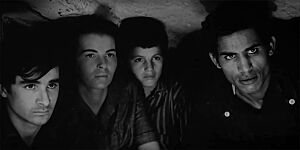
Many films have been made about Algiers, showing different parts of its history and culture:
- Algiers, 1938
- The Battle of Algiers, 1966
- Tahya ya Didou, Alger Insolite, 1970
- Bab El-Oued City, 1994
- Viva Laldjérie, 2003
- Bab el Web, 2004
- Once upon a time in the Oued, 2005
- Beur, White, Red, 2005
- Delice Paloma, 2007
- Abbott and Costello in the Foreign Legion, 1950
- Carry on Spying 1964
Notable People
Many famous people were born or lived in Algiers, including:
- Albert Camus: A famous writer who won the Nobel Prize.
- Ali La Pointe: A key figure in the Algerian fight for independence.
- Islam Slimani: A well-known footballer.
- Lyna Khoudri: A talented Algerian-French actress.
- Tony Gatlif: A French film director.
Images for kids
See Also
 In Spanish: Argel para niños
In Spanish: Argel para niños



